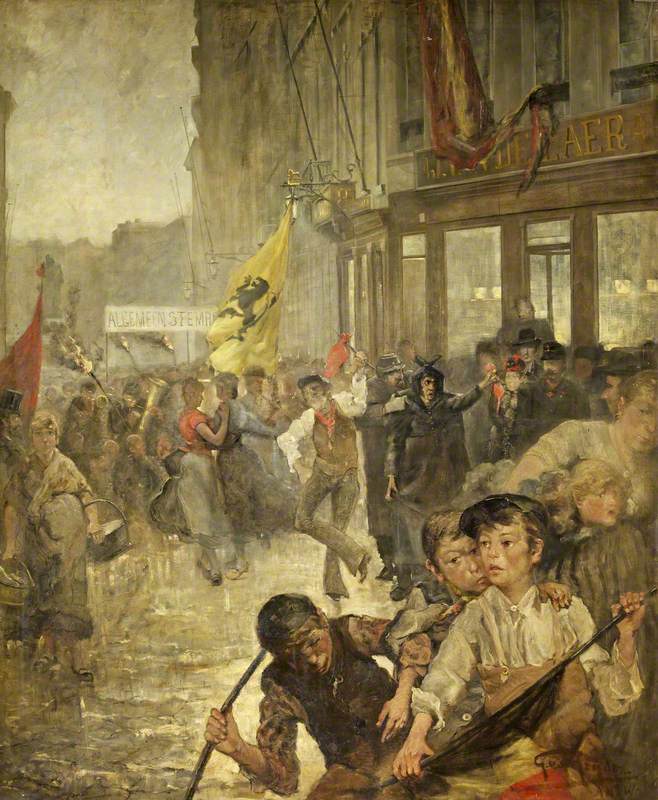
A Dutch Catholic painter of figure and landscape subjects, and portraits. Gerard van der Heyden (Gerardus Wilhelmus Maria van der Heijden) was born on 31st March 1864 in Ravenstein, North Brabant, southern Netherlands, to Petrus Franciscus Johannes van der Heijden and Albertina Joanna Maria (née Fock). He had a younger brother, Joseph Dorotheus Maria (1868–1927) who was intermittently in England from 1893 and settled there from 1897, eventually becoming a British citizen. Van der Heyden trained at the Royal Academy of Fine Arts in Antwerp, Belgium, and at some point, between 1885 and 1891 became a member of ‘Als ik kan’ (‘If I can’, motto of Jan van Eyck), the association of mainly traditional visual artists of local character founded in Antwerp in 1883 (–1952).
A moderate-size preliminary version, dated 1892, has also been recorded at sale but the large exhibited one (190 x 156 cm) is now in the Royal West of England Academy in Bristol. How it arrived there is something of a mystery but Van der Heyden himself appears to have brought it to London, where he is also reported to have worked until 1894. He probably came with his brother Joseph in 1893, hoped to sell it there, and left it behind on his return home. It was certainly Joseph who consigned it without reserve to Christie’s ‘Modern Pictures’ sale of 12th January 1895 (lot 72). It fetched only 7 guineas from someone called ‘Hill’ and thereafter passed to the showman (Sir) Oswald Stoll, who exhibited it with various others of a dramatic nature at his ‘Panopticon’ in Cardiff in January and February 1897. There it was seen as a highlight in the wide local publicity, the Cardiff Evening Express (8th February) reporting that ‘Mr Aldridge’s great picture of the Tichborne trial and Mr Van der Heyden’s painting representing the Socialists at Antwerp agitating for a general election are alone worth a visit.’ No later sale has been found and it is possible that Stoll, having had his money’s worth, may have presented it to the Royal West of England Academy (RWA, est. 1844) as part of what is called its ‘early collection’, some of uncertain provenance.
On 11th July 1895 Van der Heyden married Theodora Adolphina Weelen at Sint-Oedenrode (also in North Brabant) and spent the rest of his life in the southern Netherlands. He lived at Boxtel to 1901, at Teteringen on the outskirts of Breda to 1904 and then in Breda itself to 1928; then the Roosendaal-Nispen municipality (now part of Wouw) in 1929, Cuijk to 1932, Neerpelt in Belgium to 1937, and finally Sint-Oedenrode for his last two years.
After 1900 Van der Heyden was noted for portraits. Pieter Scheen’s, Lexicon Nederlandse Beeldende Kunstenaars, 1750–1950 (1969: second edn 1981) reports that he ‘received the [Dutch] bronze museum medal for a ‘portrait of a general’ [‘generaalsportet’] in 1901’, though lacking further detail, and in 1912 he was one of a number of artists who painted portraits of Cardinal Willem Marinus van Rossum (1854–1932), the first Dutch cardinal appointed since the Reformation. He met Van Rossum and began it in May that year, in Rome, and in August was awarded a Papal ‘Benemerenti’ silver medal, presumably in consequence of the result. (The decoration is one awarded to both Catholic clergy and laity for service to the Church.)
Van der Heyden is known to have taught three other artists – Lucas Roelfsema, Jan Theuns and (after 1908 in Breda) Laurens van Luik – and he and his early Antwerp circle are mentioned by Emmanuel de Bom (1868–1953) in his Herinneringen Aan Eenige Schilders te Antwerpen (‘Memories of Some Painters in Antwerp’, 1934): 'There they sat, some every evening, others only on Saturdays, in the yellow glow of the gaslight, snuggled together, the companions among whom I immediately distinguish: Richard Baseleer, Fik Hageman, Francis Nijs, Louis de Pooter, Arthur Briët, Antoon van Welie, Karel Theunissen, Gerard van der Heyden, for a while also Frans and Herman Deutmann, and that strangely problematic figure of the Arch-Brooder Ferdinand Muller … Gerard van der Heyden, the Noordbrabander [North Brabanter], was the nice, feisty, grumpy Catholic Dutch boy, who fancifully renamed a Schiedam [gin] an ‘eau-fortje’, who could make deliciously funny cartoons, after the two graceful daughters of the house, always surrounded by all-adoring glances.'
Only one independent exhibition of his work, ‘Living Toys’ (‘Levend Speelgoed’), is reported as taking place at Arnhem in 1901. He died at Sint-Oedenrode on 8th December 1939. Apart from the RWA painting the only identified one by Van der Heyden in a British public collection is ‘The Cathedral, Breda, The Netherlands’ (Heritage Doncaster).
Summarised from Art UK’s Art Detective discussion ‘Can we confirm the location depicted here, and who might be the artist?’
Text source: Art Detective


